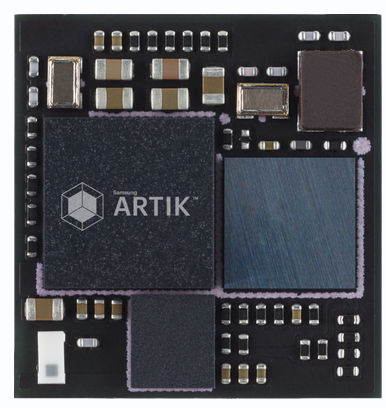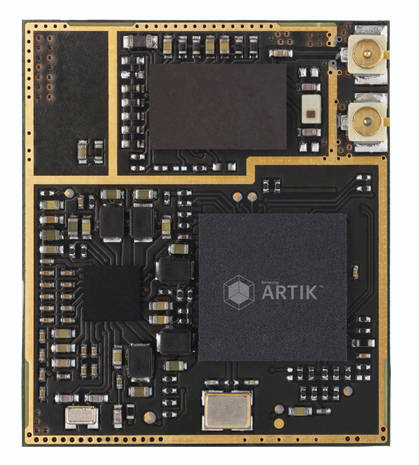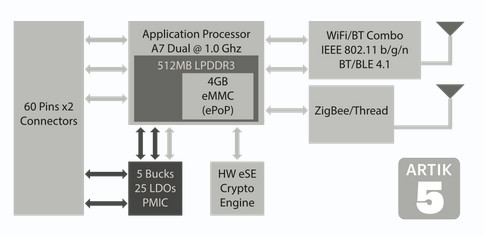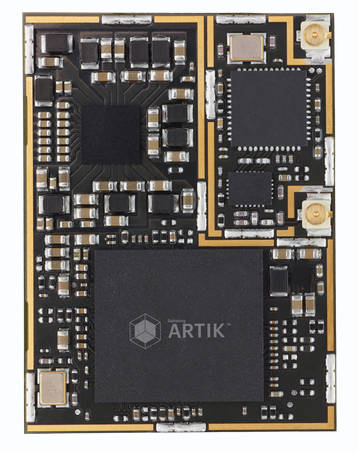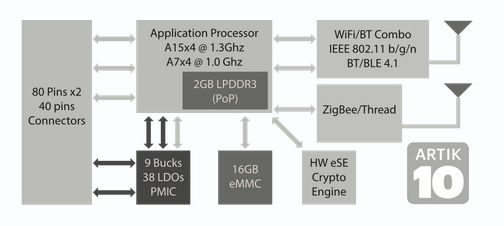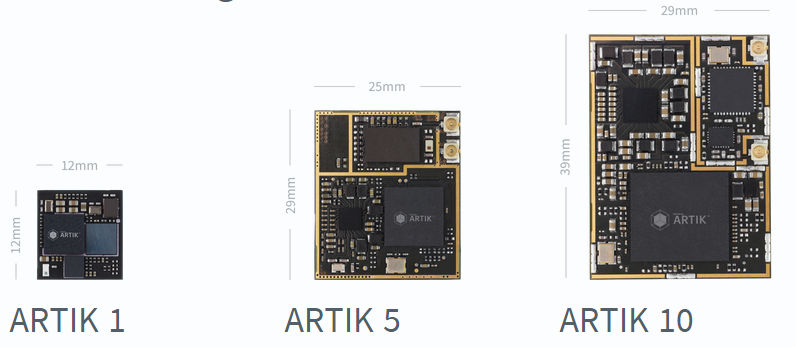| Samsung's ARTIK Arduino Compatible From Small To Powerful |
| Written by Harry Fairhead |
| Tuesday, 12 May 2015 |
|
Samsung has woken up to the Internet of Things (IoT) and decided to provide the foundation that it needs. Three new devices - ARTIK 1, 5 and 10 - span the range from tiny wearable to eight core ARM and all Arduino Certified.
The ARTIK 1 is tiny measuring just 12x12mm and is capable of running on a battery for weeks. It has a dual core processor, 1MB of RAM and 4MB Flash. It communicates with the outside world using Bluetooth Low Energy (BLE) and it has a 9-axis motion sensor. It is ideal for wearables and remote sensor applications. It also claims to have one USB OTG port with support for charging, an audio engine, and outputs to drive an RGB WVGA display.
It can work with batteries from 1.5 to 3V or more and has power management. The specification is a bit incomplete at the moment, but it also seems to have 2 UARTs, an SPI interface and 4 10-bit ADCs.
The ARTIK 5 is about twice the size of the ARTIK 1, but still small at 29x25mm. It has an ARM A7 dual core, 512MB of RAM and 4GB of Flash. This means it can run Yocto Linux. It has WiFi as well as BLE, Bluetooth and ZigBee - which more or less covers everything. It is also large enough to have two 30-pin connectors which provide:
Input power is anything between 3.4 to 5V and it works with 1.8V logic. It has a hardware video codec including MPEG 4/H264/H264/VP8 and a JPEG codec and also supports a video display, but what type and resolution isn't clear.
The ARTIK 10 is 29x39mm, making it big compared to the ARTIK 1, but you could still lose it in your pocket. It has an Octa Core ARM running at 1.3GHz. It comes with 2GB RAM and 16GB of Flash and runs Yocto Linux. It also has WiFi/BT/BLE and ZigBee. It has the same video codecs as the ARTIK 5, but with its increased processing power it can work at 1080p at 120fps. Its I/O is also bigger:
It supports a display. but there is no information on it at the moment. Both of the larger devices have GPUs. They also support a MIPI DSIM connection to allow easy connection to video cameras. All three devices have hardware security built in and they can be programmed in C/C++/Java or Groovy. You can use the standard Arduino IDE or the Samsung SDK. You can see the way Samsung is marketing the ARTIK in the following video:
ARTIK is a family of modules (ARTIK 1, ARTIK 5, ARTIK 10) tailored for the Internet of Things (IoT). With a tiered architecture built for performance, optimized power consumption and memory utilization and footprint, ARTIK is designed specifically for a variety of applications, from low-end wearables to powerful hubs with local processing and analytics. ARTIK’s best-in-class security solution includes secure element (SE) and machine learning for anomaly detection, and Trusted Execution Environment (TEE).
There is no information on pricing or on the nature of the Developer Kit - if you want one you can sign up to see if you can get an Alpha version. My guess is that it going to have to support a breakout board for all three devices, which will make any prototype device bigger than the raw measurements. There is also the small matter of the use of 1.8V logic - and again it is likely that the breakout board would provide some level of Ardunio 5V support.
There is clearly a lot we don't know as yet, but the ARTIK range look like an interesting addition to the Arduino world. What's in it for Samsung? Well, of course, it wants to be the one to provide you the cloud support that everyone seems to assume is going to be bigger than the IoT itself.
More InformationRelated ArticlesCHIP - $9 Computer To Beat Pi & Arduino Arduino Zero Pro Released Amid Legal Dispute Raspberry Pi 2 - Quad Core And Runs Windows Intel IoT Dev Kit Reaches v1.0 BBC Giving Away 1 Million Microcomputers Raspberry Pi or Programming - What shall we teach the children?
To be informed about new articles on I Programmer, install the I Programmer Toolbar, subscribe to the RSS feed, follow us on, Twitter, Facebook, Google+ or Linkedin, or sign up for our weekly newsletter.
Comments
or email your comment to: comments@i-programmer.info
|
| Last Updated ( Monday, 27 July 2015 ) |
